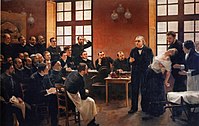
Photo from wikipedia
Abstract Hypnotic amnesia is a functional dissociation from awareness during which information from specific neural processes is unavailable to consciousness. We test the proposal that changes in topographic patterns of… Click to show full abstract
Abstract Hypnotic amnesia is a functional dissociation from awareness during which information from specific neural processes is unavailable to consciousness. We test the proposal that changes in topographic patterns of cortical oscillations in upper-alpha (10–12 Hz) band selectively inhibit the recall of memories during hypnotic amnesia by blocking availability of locally processed information at specific points in retrieval. Participants were prescreened for high or low hypnotic susceptibility. Following hypnotic induction, participants were presented with a series of 60 face stimuli and were required to identify affective expressions. Participants received a suggestion for amnesia for these faces. They were then presented with a set of 30 old and 30 new faces and identified each as old or new. Amnesia suggestion was lifted and recall tested using the remaining 30 old faces and another 30 new faces. Exact Low Resolution Brain Electromagnetic Tomography source analyses are reported for 64 channel event-related electroencephalogram recorded from highs showing reversible amnesia to old faces. For high-susceptible participants, the amnesia suggestion significantly increased old faces wrongly identified while for low-susceptible participants amnesia suggestion increased the new faces wrongly identified. There were no differences between high- and low-susceptible participants following reversal of the suggestion. For previously seen faces which were wrongly identified, compared to new faces correctly identified, (late) evoked upper-alpha is significantly higher in right BA7 in a region implicated in top-down executive control to assist recall of visual information. Lagged nonlinear connectivity between cortical sources in upper-alpha in the same condition showed significantly increased connectivity between right BA34 (parahippocampal gyrus) and right BAs 7, 20 and 22. Integration between these regions is essential for recall of recent faces. During amnesia, spatial and temporal coordination of upper-alpha appears to suppress integrated functioning of these regions (hence recall). These patterns were absent after reversal of amnesia suggestion.
Journal Title: Neuroscience of Consciousness
Year Published: 2017
Link to full text (if available)
Share on Social Media: Sign Up to like & get
recommendations!